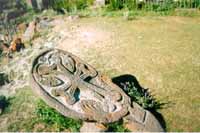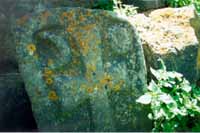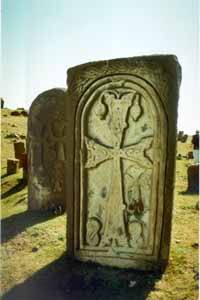|
Exposed to repeated invasions by hostile neighbors, Armenia developed her artistic tradition in cycles. These cycles came in relatively short spurts, influenced by repeated incursions from outside empires. As a record of the unique and ever-evolving Armenian art forms, Khachkars serve as important historical markers, beginning in the 4th century when simple wooden crosses were erected at pagan temples by Gregory the Illuminator and his converts. Gregory the Illuminator is described in historic accounts as leading a "holy war" against Pagan temples, converting or destroying them en masse. The historian Agatangeghos notes that Gregory erected crosses at Vagharshapat (Echmiadzin) at the site of the martyrdom of Hripsimeh and the 39 virgins, which later became the Martyria and 7th c. Hripsimeh church. According to tradition wooden crosses were erected throughout the country, including the Lake Sevan island and at Sanahin. Serving as quick monuments to the new Christian faith, wooden crosses were effective and quick signatures of a locality's conversion.
 Stone forms from the 4th c. were more primitive, erected on
the sites of pagan temples before churches were built. The early
Christian obelisks are composed of two parts, a plinth and a
perpendicular mass which is inscribed with the sign of the cross.
The obelisks themselves are survivors from Pre-Christian pagan
obelisks, the new inscriptions an early attempt to "convert"
them to the new religion. Examples of 4th cc Christian obelisks
can be found at Avan, Ardvi, Dsegh, Odzun and Brdadzor. An exceptional
example is an obelisk at Nerkin Talin, a huge triangular boulder
engraved with a cross.
Stone forms from the 4th c. were more primitive, erected on
the sites of pagan temples before churches were built. The early
Christian obelisks are composed of two parts, a plinth and a
perpendicular mass which is inscribed with the sign of the cross.
The obelisks themselves are survivors from Pre-Christian pagan
obelisks, the new inscriptions an early attempt to "convert"
them to the new religion. Examples of 4th cc Christian obelisks
can be found at Avan, Ardvi, Dsegh, Odzun and Brdadzor. An exceptional
example is an obelisk at Nerkin Talin, a huge triangular boulder
engraved with a cross.
The earliest attempts to replace wooden crosses with stone crosses dates to the 4th-7th cc. These include 'wing crosses', some found during the excavation of Dvin. A few examples of 4th-5th cc Khachkars can be found at secluded sites in Armenia in particular Dzoragiugh in Martuni region, Lori and Kapan. Early Khachkars incorporated a combination of pagan and Christian symbols. It helped that the same symbols used by the new Christian faith were also widely used by pagan believers: the cross itself was a cosmic symbol of life, as was the fish, the sun and the sacred swastika. These symbols found themselves receptive audiences in the population, and were used in early Khachkar designs.
 4th-5th cc khachkars were carved on stones rounded on the top
edge, sloping to the North. These early Khachkars can be detected
by the sun and moon which were carved on the upper Spaces of
the stone, between the head of the cross. Symbols of the cycle
of time, they are direct descendants of both Zoroastrian and
zodiac worship forms. The cross is either simple in form, or
holds a spiral sun disk on the tips of the cross ends.
4th-5th cc khachkars were carved on stones rounded on the top
edge, sloping to the North. These early Khachkars can be detected
by the sun and moon which were carved on the upper Spaces of
the stone, between the head of the cross. Symbols of the cycle
of time, they are direct descendants of both Zoroastrian and
zodiac worship forms. The cross is either simple in form, or
holds a spiral sun disk on the tips of the cross ends.
Another tradition devised in pagan times and which found its way into Khachkars was carving the design on the Western face of the stone, with inscriptions on the Eastern face. Since the body was laid to rest oriented to the East, the stone was a marker for the setting sun, which was a symbol for the end of the world and the last Judgment. Churches always orient the altar to the East, a direct inheritance from pagan temples, and one that continues to this day.
 Beginning in the 7th century, the Khachkar began to change,
as sun and moon symbols were dropped in favor of a more elaborate
design representing the tree of life. The top of the stone is
still rounded, but it is more symmetrical. The solar disks continue
throughout the development of the Khachkar, with the Tree of
life becoming more and more elaborate in the background. Fruit
of the tree (palm branches or bunches of grape) is often carved
in place of the sun and moon used in earlier stones.
Beginning in the 7th century, the Khachkar began to change,
as sun and moon symbols were dropped in favor of a more elaborate
design representing the tree of life. The top of the stone is
still rounded, but it is more symmetrical. The solar disks continue
throughout the development of the Khachkar, with the Tree of
life becoming more and more elaborate in the background. Fruit
of the tree (palm branches or bunches of grape) is often carved
in place of the sun and moon used in earlier stones.
In the mid 7th century, Arabs swept into Armenia, destroying much of the imperial and religious architecture from the previous era, and a decline in church construction ensued. The focus of artistic expression was placed on smaller monuments, just as church design tended towards compact structures. The Khachkar became a more important focus of spiritual expression, and a unified form began to emerge. This form based on early wooden and stone wing, the rounded top stone crosses, and early Christian obelisks became the basis for a unique Armenian art form--Khachkars.
|